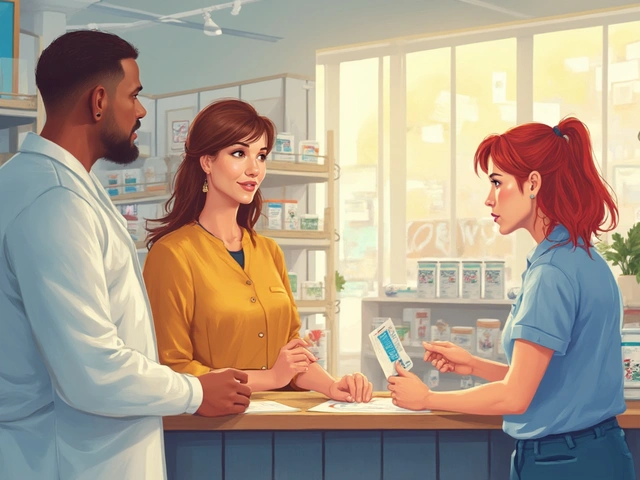Forget scrolling past another medical term—erythromycin has probably played a bigger role in your life, or in your family’s, than you realize. You might’ve swallowed those big red-white capsules for a nagging cough, or dabbed a cream on acne only to see real results. Here’s the deal: erythromycin isn’t one of those forgotten drugs doctors hardly use anymore. In June 2025, it’s still saving throats, skin, and sometimes lives all over the world. Now’s the time to get behind what makes erythromycin tick—and how to dodge the bumps along the way.
What is Erythromycin and How Does It Work?
If antibiotics had a hall of fame, erythromycin would be a first ballot candidate. First introduced back in 1952, it’s the go-to for doctors when penicillin allergies throw a wrench in their plans or when nasty bugs grow resistant to other drugs. The magic lies in how erythromycin messes with bacteria. Basically, it sneaks inside bacterial cells and makes it impossible for them to grow and multiply. It blocks a key step in building proteins—which is kind of like cutting off the Wi-Fi during a Zoom meeting, but for bacteria. No proteins, no survival. That’s really the heart of it.
Erythromycin belongs to a family called macrolide antibiotics. Picture a ‘macrolide’ as a big, sturdy ring structure; this design helps the drug stick to bacterial ribosomes (the little factories cranking out proteins) and gum up their gears. We’re talking about bacteria that start a lot of common trouble: group A strep (think strep throat), staph (causing some gnarly skin infections), and some less famous cousins like Moraxella and Chlamydia. Erythromycin even puts up a fight against certain bacteria that have built up resistance to other drugs. For millions of prescriptions written every year, that’s peace of mind.
Here’s something people usually get wrong: antibiotics, including erythromycin, do nothing for viruses. So colds, flus, and COVID-19 are way outside this drug’s territory. Asking for erythromycin to knock out a sniffle won’t help and might even spark antibiotic resistance, which means bacteria get smarter over time and future infections will be harder to beat. Trust the doctor when they say “no”. They’re just thinking ahead.
Interestingly, erythromycin is on the World Health Organization’s List of Essential Medicines, which is like their master list of drugs that every health system needs. It’s safe for most people, works well, and doesn’t cost as much as many newer gals in the pharmacy aisle. And according to a 2024 report in the Journal of Infection, erythromycin use actually ticked up a bit in rural clinics across Southeast Asia, mostly because bacterial resistance rates to older, first-line antibiotics shot past 20% in some regions. That kind of flexibility is what has kept erythromycin famous for more than seventy years.
Wondering how it moves through your body? After popping a pill or swallowing a syrup, erythromycin absorbs quickly—though it doesn’t like acid, so some forms need a special coating to survive your stomach. Bloodstream, then tissues, and finally it collects where the infection is setting up shop. A typical course lasts seven to ten days, and somewhere in the middle you (hopefully) start feeling better. But don’t quit halfway, even if you’re ready to run a marathon—stopping too soon doesn’t allow all the bacteria to die off.
Common Uses and Surprising Benefits of Erythromycin
Erythromycin isn’t just hanging out for a single job. This antibiotic pulls double—and sometimes triple—duty. If you’ve had strep or a chest infection while being allergic to penicillin, there’s a good chance you’ve said hello to erythromycin. Doctors lean on it for classic infections: strep throat, some forms of pneumonia, and skin infections ranging from impetigo to cellulitis. But that’s just the standard gig.
One of the more popular uses is in the world of acne. That’s right: erythromycin shows up in both creams and gels to tackle the kind of breakouts that laugh at your old skincare routine. Unlike some harsh drugs, it’s gentle enough to use for months, and dermatologists stick with it because, as of 2025, it still handles some of the most stubborn acne bacteria. A 2023 study in the British Journal of Dermatology showed topical erythromycin cleared up moderate acne cases in teens as effectively as clindamycin, but with fewer side effects. So if your cheeks and jawline have been giving you grief since high school, erythromycin is still a trusty backup.
But wait—it gets weirder. Gastroenterologists sometimes prescribe erythromycin to folks with slow stomach emptying, known as gastroparesis. Here, the drug jumpstarts stomach contractions, thanks to its action as a “motilin receptor agonist.” Translation? Your stomach gets moving, and your bathroom habits thank you. Doctors will pick this option when other meds strike out or don’t play well with a patient’s other health needs. Now, nobody chugs a bottle of erythromycin just to fix heartburn or gas—that’s not the move—but it’s pretty neat that a humble antibiotic moonlights as a gut-helper.
Pediatricians lean on this medicine, too. Young kids, especially newborns, sometimes pick up a nasty eye infection during birth (think Chlamydia trachomatis). Eye ointment with erythromycin is the gold standard in newborn nurseries, slathered on the day babies enter the world. This single precaution saves infants from some dark, vision-robbing infections; it’s one reason why Western countries practically wiped out neonatal conjunctivitis linked to these bacteria.
People who work in hospitals know erythromycin has another behind-the-scenes role. If you’re hooked up to a feeding tube and the contents aren’t going anywhere, a short erythromycin course can “prime the pump.” It’s not for long-term use in this case, but anyone who’s stopped vomiting and gotten back to solid food knows how game-changing this can be.
Veterinarians get mileage out of erythromycin, too, especially for treating respiratory infections in cats, dogs, and even backyard chickens. Livestock farmers swear by it to stamp out outbreaks before they wipe out a flock. Just be aware, rules now limit how antibiotics are given to animals so humans don’t end up with resistant bugs on their plate.
There are fewer surprises on the dental front, but erythromycin still tags along as a preventive antibiotic before certain dental surgeries, especially for patients at risk of bacterial endocarditis—an infection of the heart lining. It’s not the first pick, but if someone can’t tolerate other antibiotics, it steps in. So next time your dentist updates your med chart, now you know why erythromycin isn’t so rare after all.

Side Effects, Drug Interactions, and Real-World Safety Tips
No drug’s perfect—not even erythromycin. If there’s one word most folks connect with erythromycin, it’s probably “stomach.” Nausea, upset stomach, or diarrhea are basically its calling cards. Around 20% of people taking oral erythromycin will notice at least mild stomach trouble. For most, it’s nothing more than a little discomfort and settles down after a meal or some ginger tea. Still, if you’re running to the bathroom more than usual or your stomach feels like a washing machine, don’t tough it out. Let your doctor know, because sometimes the drug dose or formulation can be swapped.
But that’s not the whole picture. On the rare side, some folks get allergies: itchy rash, swelling, or trouble breathing—if anything like this pops up, it’s time for urgent medical care, not a selfie for social media. Liver bumps can happen too, especially with longer use or in people with existing liver disease. Yellow eyes or skin (aka jaundice) means the medicine needs to stop right away. There’s also a small risk of hearing issues if you’re on high doses for a long time, especially if you have kidney problems. Watching for these severe effects is key—no one wants to mess around when it comes to hearing or their liver.
Now, here’s a big heads-up for anyone on other medications: erythromycin is famous for mixing things up where it shouldn’t. In the liver, it slows down enzymes (CYP3A4 to be exact), which means other drugs can stick around longer in your system. The all-stars of drug drama? Blood thinners like warfarin, cholesterol meds (statins), certain heart rhythm pills, seizure medications, and even some birth control pills. The risk: higher levels and side effects from these drugs, purely because *erythromycin* slowed things down too much.
This isn’t a list to memorize, but here’s a quick visual that sums up erythromycin’s most common side effects and cautions:
| Side Effect | Approximate Frequency (%) | Notes |
|---|---|---|
| Stomach Upset | 20 | Common; often mild |
| Diarrhea | 10 | Reduce dose or use probiotic |
| Rash/Allergy | 1-3 | Call doctor urgently |
| Liver Effects | Less than 1 | Look for yellowing skin/eyes |
| Hearing Issues (high dose, chronic use) | Less than 1 | Very rare; report any changes |
A quick tip: always check your pharmacy handout for a list of what to avoid on erythromycin. For example, mixing it with grapefruit juice is a terrible idea—the juice makes the drug’s effects stronger and could up the risk of side effects. Same with alcohol: keep it minimal because your liver already works overtime to filter the antibiotic.
What about kids and older adults? Pediatricians measure doses by weight, since little ones can be more sensitive to the stomach annoyances. For seniors, doctors take care to check kidney and liver function before starting a course, as these organs often work a bit slower with age. Pregnant people can use erythromycin (it’s Category B in the old system), but certain forms—notably erythromycin estolate—aren’t the best pick late in pregnancy, due to rare liver complications. Doctors usually switch to erythromycin base or ethylsuccinate to be safe.
If you miss a dose, don’t double up. Just take it when you remember and get back on schedule. And always finish the full prescription, even if you feel like you could chase down a bear. That’s what keeps resistance at bay and knocks out the infection for real.
Tips for Safe and Effective Use: What Real People Should Know
Nobody wants to mess up something as basic as taking antibiotics, but all those tiny rules do matter. Here’s how to make erythromycin work for you, and not the other way around.
- Erythromycin works best on an empty stomach, but if the nausea gets too real, you can take it with a light snack. Just avoid big, fatty meals—they slow absorption and make you more likely to feel queasy.
- There are special long-acting, enteric-coated forms. Don’t crush or chew these, or you’ll end up with a bitter aftertaste and possibly less effect. Swallow them whole with water.
- If you’re using a gel, ointment, or cream for skin, wash the area first. Don’t slather on a thick layer—that won’t speed things up, and could irritate. Be consistent, applying once or twice daily as directed.
- Track your symptoms. If you’re not feeling any improvement by day 3, call the doctor—bacteria might be resistant and you’ll need to switch.
- Set reminders for your doses. Missing antibiotics lets the bacteria regroup, and repeating courses means side effects become more likely.
- Let your doctor know about any medications, herbal products, or supplements you use. Even “natural” stuff can interfere—St. John’s Wort, in particular, is notorious for drug interactions with erythromycin.
- Don’t share your leftover pills or creams. Not only is that illegal in most places, but it can drag out symptoms or create resistant bacteria in your friends and family. If you have extra, return it to your pharmacy for safe disposal.
- For parents: keep oral suspensions in the fridge if the label says to—but not in the freezer. Shake the bottle well, and always use the dosing syringe or spoon you got from the pharmacy, not your kitchen silverware.
- Older folks: move slowly after taking erythromycin, especially the first few times. If you feel dizzy or faint, sit down and hydrate. Your blood pressure might dip a bit until your body adjusts.
The last real-world tip: most bacteria are invisible, but resistance is absolutely real. The U.S. CDC estimated over 35,000 deaths in 2023 from antibiotic-resistant infections. Taking antibiotics as prescribed, not sharing, and finishing the full course is what keeps these numbers from rising. Erythromycin has earned its place in medicine cabinets for a reason—respect it, and it’ll keep delivering where needed.




Wow, this was a really clear and concise explanation of erythromycin! I appreciate how it breaks down the uses and precautions without making things too complicated. 🙂
One thing I find really important to highlight is how critical it is to finish the entire course of antibiotics, even if you start feeling better early. Stopping too soon can lead to antibiotic resistance, which is a huge problem worldwide.
Also, I noticed that the article touched on drug interactions. Sometimes people underestimate how certain medicines can affect each other – always best to consult your doctor or pharmacist before mixing medications.
Have any of you experienced side effects from erythromycin? I remember once getting mild stomach upset, but my doc mentioned that probiotics can sometimes help with that.
Overall, this post is a great primer for anyone who wants to understand this antibiotic better without getting lost in medical jargon. Thanks for sharing!
Honestly, I don’t get why people freak out about antibiotics. They’re essential, especially in a country like ours where infections spread quickly. This article lays down the facts straight, no fluff.
But let me tell you, the misuse of erythromycin and other antibiotics is a disaster here. People often pressure doctors for these drugs thinking they’ll cure everything overnight. Newsflash: they won’t.
Also, some folks neglect the side effects or warnings, which just leads to more complications. You MUST be informed before popping any pills.
Good to see such content, but honestly, India should double down on educating the masses about correct antibiotic use. Otherwise, resistance will skyrocket.
Does anyone else here think antibiotics are overprescribed around the world?
Oh please, before indulging blindly in erythromycin, one must consider the host of pharmacodynamic and pharmacokinetic implications lurking beneath the surface!
The toxicological profile of erythromycin is not to be underestimated, and while the article addressed side effects, it fails to include the full spectrum of iatrogenic potentials.
Patients ignorant of these myriad complications might find themselves embroiled in drug-drug interactions that could precipitate severe cardiac arrhythmias.
Not to mention, the myriads of reports indicating hepatotoxicity risk that are conveniently glossed over.
This is no facade of panacea; this antibiotic demands cautious administration under strict clinical supervision.
Anyone else feel this article, while accessible, somewhat sanitizes the gravity involved?
Well, while I agree with some points here, I think the article is a bit too simplistic. I mean, sure, erythromycin can be effective, but it’s heavily over-prescribed here in Australia, and that’s a problem.
Instead of focusing only on what it can do, we should also discuss appropriate stewardship. If doctors keep handing out antibiotics like candy, we’re going to lose them sooner rather than later.
The side effects are often downplayed, and patients might not be fully aware of risks like QT prolongation or severe gastrointestinal upset.
Plus, there are emerging data about resistance patterns that warrant more emphasis on when and why erythromycin should be used.
Does anyone have any good resources on antibiotic stewardship?
Here’s my two cents: Everyone acts like antibiotics are some magic cure, but the misuse is just ridiculous. I’ve seen people self-medicating and making their conditions worse. It’s frustrating.
The article explains the basics well, but honestly, I wish there were more warnings about the dangers of ignoring a doctor’s advice or mixing drugs irresponsibly.
Also, the social impact of antibiotic resistance should be front and center in any discussion like this. We’re facing a crisis that could make common infections deadly again.
What do you all think about stricter regulations on antibiotic sales?
This article is a decent primer, but I can’t help but notice it falls short in addressing the philosophical implications of our reliance on drugs like erythromycin.
Yes, it treats bacterial infections effectively, but what about the larger ethical question: Are we nurturing a dependency that outweighs natural immune development? Does widespread use diminish our collective resilience?
I'm always intrigued by how scientific progress intertwines with societal shifts and how we’ve moved toward medicating almost every ailment.
Does anyone else ponder the long-term cultural consequences of such medical interventions?
Food for thought beyond the immediate clinical.
Thank you for the well-articulated overview. It is essential to recognize that erythromycin remains a cornerstone in antimicrobial therapy but demands prudent clinical application.
The dangers of hasty prescribing practices cannot be overstated, especially regarding resistance genomics and the preservation of microbiota integrity.
Moreover, attention must be directed toward educating patients on adherence and potential adverse effects to optimize therapeutic outcomes.
Could we consider protocols to ensure better patient compliance and minimize inadvertent harm?
Appreciate hearing others' professional insights or lived experiences.
I find this piece to be quite informative and suitably balanced for a general audience.
It would be beneficial, however, to include more detailed case studies highlighting common scenarios where erythromycin use is indicated or contraindicated.
This could aid readers in recognizing the nuanced decisions clinicians face daily in antibiotic prescription.
Furthermore, expanding on the monitoring of side effects and drug interactions could empower patients to self-advocate during treatment.
What does everyone think about integrating such user-friendly clinical scenarios into public education?
Great breakdown of erythromycin here, honestly! :) I think a lot of people don’t realize just how essential it can be for certain infections, especially if you’re allergic to penicillin or something.
The part about drug interactions is super important too—mixing medications can get tricky, so always check with a doc or pharmacist to keep safe.
I had a buddy who had to take erythromycin once, and it upset his stomach pretty bad, but then after a couple of days, he was feeling much better. That’s how it goes sometimes.
Anyone else had different side effects or tips to share? Let's keep this thread going!
Ugh, more anti-bacterial snake oil nonsense. Seriously, people act like erythromycin is the cure-all and skip over the fact it has some nasty interactions and side effects.
And those side effects can be brutal if you have any pre-existing issues. Don’t buy into the hype without doing your own research.
Honestly, posts like this make me roll my eyes just because they don’t emphasize the risks sufficiently and just boost pharma propaganda.
Anyone else here get the bad end of erythromycin treatment? Share your horror stories!
Thank you everyone for sharing such varied insights on erythromycin and its role within the medical landscape. I have to say, while the article serves a valuable purpose in demystifying antibiotic use, the spectrum of views here highlights how multi-faceted this topic truly is.
It is critical that we advocate for educational approaches that empower laypersons with both knowledge of benefits and risks. Moreover, we must be vigilant in encouraging discussion around appropriate use patterns to mitigate resistance globally.
In my experience, clear communication from healthcare providers is indispensable in achieving compliance and minimizing adverse outcomes.
Does anyone have suggestions on better ways to educate patients beyond standard leaflets and pamphlets?